
The discussion on whether we should prioritize modern technologies in healthcare systems is over. Due to the pandemic, a lot of people were recently forced to change how they approach technology in health settings. Research conducted by The Health Foundation found that around 60% of NHS users increased their use of technology to access care during the first phase of the COVID-19 pandemic. An overwhelming majority (83%) viewed their experiences positively.
However, when comparing those solutions to traditional models of care, 42% of NHS users who had increased their use of technology said they made for worse quality of care. This highlights the need for further development and improvement of the technology implemented during the pandemic. According to The Health Foundation “The fast pace at which they were introduced means that important steps – such as evaluation and co-design with patients – will necessarily have been shortcut".
Thanks to the recent rise of tech companies, we have gotten accustomed to rapid product development and digital disruption in every industry touched by it. A common assumption is that anything can be made morre simple and more efficient with digital technologies, even health services. However, while in digital we are familiar with the principle of “Move fast & break things”, in the healthcare industry this can translate into “Move too quickly and break your company”.
Underestimating the complexity of stakeholder groups and how they are connected is the most common mistake made in product development. Teams try to build direct-to-consumer propositions, without realizing that healthcare professionals and insurers are the gatekeepers to consumers. 61% of digital health companies that start B2C end up pivoting to B2B and selling to insurance companies, employers, hospitals, or other healthcare providers.
Usually, this type of pivot is expensive and the obvious question is, why does this happen?
After working with many corporates in the industry, we came to our own conclusion: management teams are so charmed by the possibilities of technologies that they forget to invest in understanding the people who use them. Luckily, this generalization does not always apply. During the past 10 years, pharmaceutical and medical companies started using patient-centric principles and 85% of companies planned to raise their investment in patient-centric capabilities in 2020.
Unfortunately, if your team is just getting started with this process, you might find the information shared too high-level and rarely applicable to your work. We want to change that by sharing a better approach to creating digital solutions in healthcare.
Instead of inventing state-of-the-art technology that doesn’t have a clear use, we focus on understanding the root causes of healthcare problems and then designing a technology that solves them.
This is also known as need-driven innovation, an approach used at Stanford University for designing and developing medical technologies.
Let’s get started.
Project teams are too often composed of marketeers, managers, and other internal roles. Users are rarely involved end to end, yet that is exactly what we need to do. This is a critical part of building a strategy, as the people you're designing products for are often different from the people you're designing products with.
For example, if you’re looking for a way to track the time your kids spend on their phones, it’s natural that your favorite solution will likely look like it was designed by someone who has children themselves.
The benefits of co-designing are multifold In the short term, the resulting ideas will be more creative and inclusive, while your team will be forced to think outside-in. Concepts can be validated on the spot, which will eventually reduce the risk of failure. In the long-term, your brand will benefit from a better relationship with your customers and produce natural ambassadors, while your business grows a user test base that makes product development faster and easier.
In other words, it’s essential to co-design solutions with product users (e.g., patients, professionals, insurers, etc.). However, it does not stop there. To be successful, your team also needs to be cross-functional. Typically, that means people from marketing, IT, design, sales/support, and operations. Diverse teams tend to create better solutions because they can source from a variety of insights on what things are important, how they work, how they are connected, what pitfalls might be encountered further down the road and how to solve them. If that isn’t enough, involving people from different teams will help you get the necessary commitment and push the initiative forward.
Once you have the right people together, you can start running.
Great solutions are grounded within the unmet needs of your problem space. Therefore, we start by focusing on the key issues, existing solutions and the needs of all stakeholders involved (insurers, healthcare professionals, patients etc.).
As you might imagine, that means involving external parties early in the process. The research tools that we use combine both qualitative and quantitative methods, from classic interviews all the way to using data science to find patterns in behavioral data. The diagram below should give you an idea of the activities you should conduct in this phase.
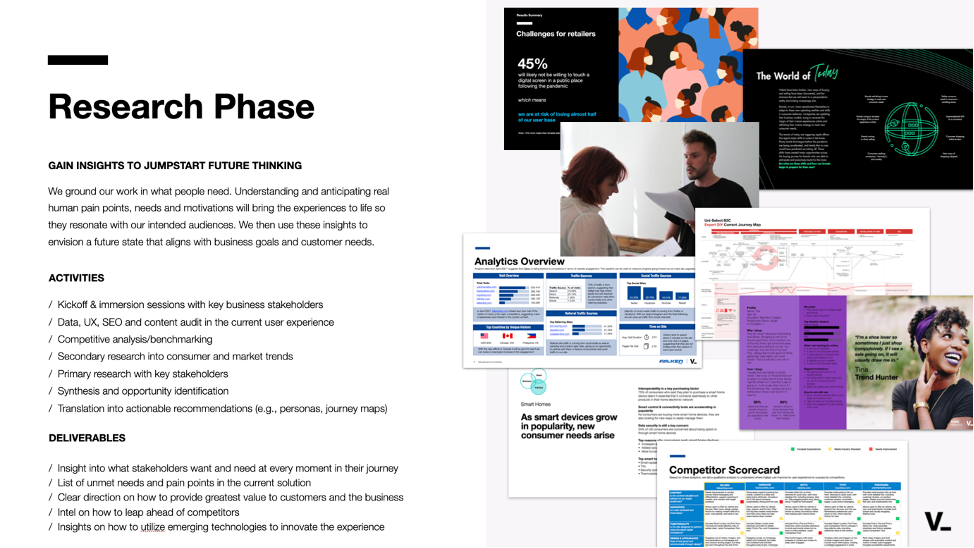
We don’t want to rush this phase, as the insights produced will allow the team to envision a future state that aligns with business goals and stakeholder needs. Once a fair amount of information has been gathered, we consolidate everything.
Journey maps are great to visualize either existing experiences that need improvement or new experiences (current-state vs future-state, or IST & SOLL). Typically, journey maps focus on the human experience only, illustrating the story of a specific actor as a sequence of steps.
However, the flexibility of this tool allows you to attach different types of information when needed. Examples include touchpoints, pains & gains, supporting technologies, business & technology processes, critical assumptions, emotional situation, KPIs, etc. Depending on what information you’re attaching and the purpose of the map, you might find them also referred to as ‘Service Blueprint’, ‘Experience Flow’, ‘Customer Journey’, and so on.
An important aspect of this exercise is to make your stakeholders the center piece of the canvas. That means that the information included in the bottom lanes should relate to what the stakeholders are doing in the top lanes.
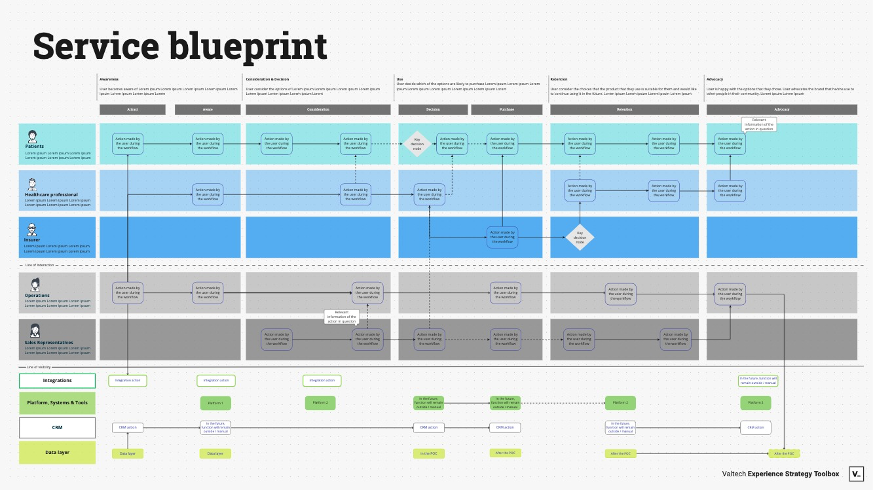
Note:
You can use this canvas as a consolidation tool for your research. Just map your research and then ask yourself which steps are not clear yet? Where are the assumptions? Where are the pain points and opportunities?
How to use the canvas:
We start by choosing the main personas that will be part of the journey. In healthcare, this often means mapping several groups:
Then we define the scale of the journey by mapping its phases. This allows us to define the time frame of the experience: is it a 10-minute or a 10-month experience? The phases are noted at the top of the canvas. An example is “Problem awareness, Diagnosis, Consideration, Purchase, Initial experience, Ongoing treatment”.
Once the phases are outlined, we fill in the steps of the journey for each persona. Sometimes it helps to start with the most crucial steps and then ask yourself what happens before and after. One thing you will probably encounter is that the personas often interact with each other during the journey. Embrace that complexity and try to map clearly how and when the personas interact. You might find untapped opportunities in these moments.
Depending on the purpose of the journey map, you can add more lanes at the bottom to include specific information of the experience, such as the channels used, backstage processes, platforms used, data exchanges, and others. Often, the purpose of the journey map and research data at hand define which additional lanes you’ll need to add to obtain a complete picture.
When all the steps are mapped, you can add a layer of information on top by using the insights from your research. Use icons and comment bubbles to highlight important information. These include unresolved pain points, ambitions and hopes, unsolved user goals, opportunities, and anything else that ends up being important.
Go through the journey from end to end to check if you missed a step or if you need more/fewer details in certain parts. You can always break up a step into several or condense several steps to one. Often, it makes sense to find a consistent level of detail throughout the whole journey map or to highlight a specific part of the journey in more detail. Invite real customers or other relevant stakeholders to give feedback and then use their feedback to refine it.
After the journey is complete, typically a moment of reflection follows, where the team discusses the findings and prioritizes the steps that will determine the focus of the next phase.
By now, you should have enough information to start thinking about your vision and objectives. In other words, what the solution should aim for.
There are several ways to define a vision. However, often vision statements are only qualitative and do not provide a way to measure whether the team is heading in the right direction. We like to solve that by mixing vision building with metric setting. The North Star Framework is one way of doing that, helping us to identify a crucial metric that best captures the core value of the product that you deliver to your customers.
This single metric is called the North Star Metric. It is a leading indicator defining the relationship between the key customer need you are trying to solve and sustainable, long-term business results. The image below shows the canvas that we frequently use for this exercise.
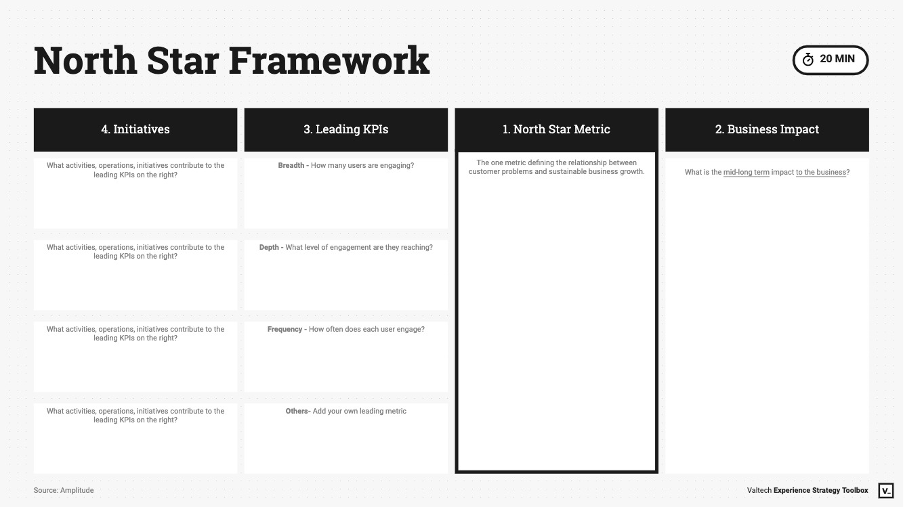
After defining the North Star Metric, you can take a look at its leading KPIs. This is useful if you have already defined a solution or if there is an existing one that you’re reconsidering. The leading KPIs are divided by the following categories:
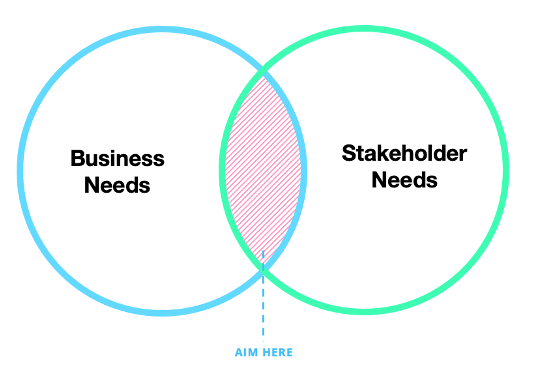 | Make sure that these KPIs are relevant to your needs and your key stakeholder’s. Once you have a clear vision and metric, you can start co-creating a digital experience that caters to all main audiences. |
Make sure that these KPIs are relevant to your needs and your key stakeholder’s. Once you have a clear vision and metric, you can start co-creating a digital experience that caters to all main audiences.
As you get familiar with your audiences, you will notice that there are some key moments in which they could find value in your solution. However, they are often disconnected and hard to map on a classic journey map.
Think about the time we spend visiting a pharmacy or a clinic. Usually, it is combined with waiting times, open questions and doubts that come with that experience. Those are opportunities for brands to stand out and create value in a memorable way. So, what do we mean by ‘micro-moments’ and why should we care about them?
A micro-moment is when people reflexively turn to a device—increasingly a smartphone—to act on a need to learn something, do something, discover something, watch something, or buy something. There are several types of moments that can be leveraged, depending on if you operate in B2B or B2C. Below we have created an overview for you.

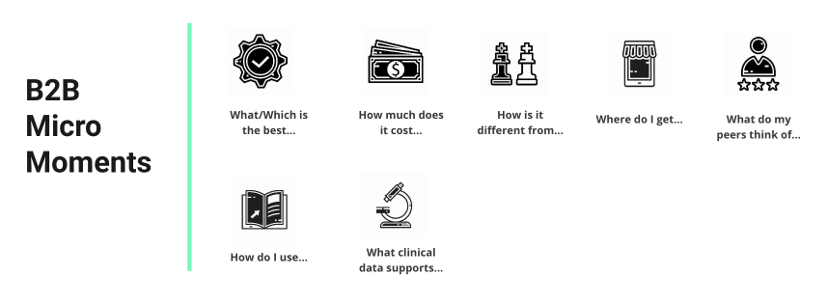
From a behavioral perspective, the case for micro-moments seems clear. According to Google research:
A success case from using micro-moments comes from one of the top three most innovative pharmacy companies in the U.S., CVS Health. They leveraged micro-moments with their ‘caregiver’ audience. Their objective was to simplify how caregivers manage and monitor the daily medications that their family members need to take. Whereas usually this takes a lot of time, they wanted a simple solution with a few steps taken on a smartphone. The result?
CVS created an app that allows its users to organize their prescriptions, medication, and insurance details. The app can also send daily medication reminders and notifications for picking up a new prescription.
By taking action and shaping these micro-moments, CVS has seen a tangible impact from easing a customer’s pain in their daily life. Following this success, CVS Health has increased its investment in digital by 500% in the last two years. 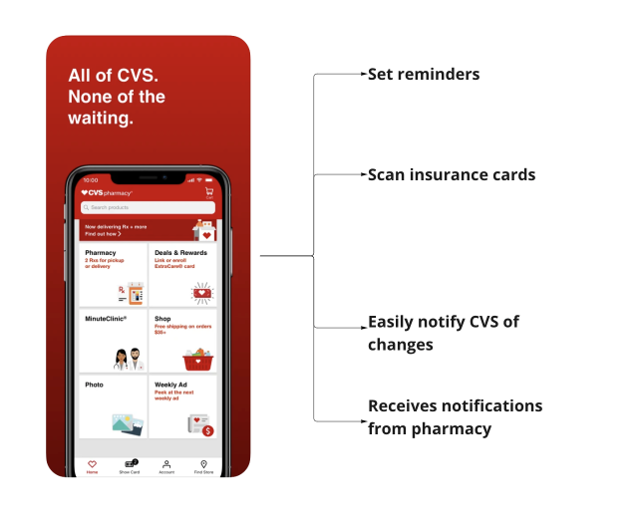
How do you get started with micro-moments?
As you map your audience’s journey, put yourself in their shoes and think about where the biggest questions in that journey are, and how you could turn them into an opportunity.
For example, when someone goes to the dentist, they might wonder about which toothbrush is the most effective. They might even ask the dentist to refer them.
Therefore, companies could think of ways to be relevant in those moments, by creating supporting materials, being present in search results, backing up your claims and technology with medical studies, or perhaps creating a partnership with insurance companies that cover dental health.
What’s important is that you look at micro-moments holistically and not as an exercise that only a certain role in the company needs to consider. So far, Google has made this framework known across the marketing communities, but there is no reason why design and strategy teams shouldn’t take advantage of it.
After creating a measurable vision and some micro-moments to leverage as experiences, it’s important to understand if the team is going in the right direction. Creating a prototype and collecting feedback from others before building anything is the best way to do that.
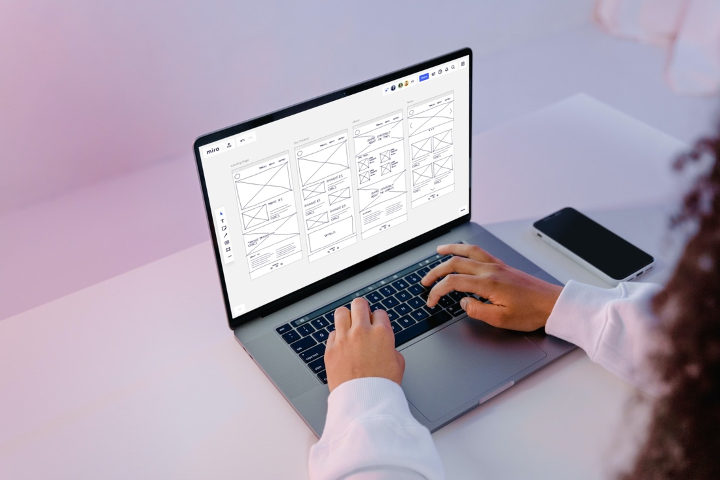
First, you want to take the micro-moments and prototype their experiences in low fidelity. Prototyping in low fidelity helps you uncover all the assumptions and risks for failure that you didn’t consider before. It’s an invaluable tool for understanding whether your ideas add value to the audiences you are targeting.
Next, you want to review your prototype with your professional and consumer audiences, as well as your internal colleagues. This includes IT, design, process experts and business units. Often, we see that organizations work in silos, but that never helps when you want to create something new. Reviewing your designs with other stakeholders allows you to foresee the upcoming challenges, assess technical feasibilities, or uncover other aspects that you might have missed while you designed the wireframes.
After you collected feedback, you’ll want to consolidate everything and decide whether to persevere, pivot or even kill the concept. If you decide to persevere, the road ahead is long but exciting.
As the digital health industry is rapidly changing, we see that there are many challenges, as well as opportunities for healthcare companies to grow and finally provide solutions that prevent problems, instead of fixing symptoms. We believe that creating a great digital product is not just about technology, but understanding the people who will use it and constantly iterating your product strategy as you learn more about their needs.
Involving stakeholders and being aligned with them throughout the design process is essential, as they are the ones who know enough about the audiences, capabilities and feasibilities while building or improving your digital products.
Finally, if you have a health product idea and want to explore it, don’t hesitate to reach out!

Marco Bar Goria
Senior Digital Consultant
Valtech

Siti Restuningrum
Associate Consultant
Valtech
The original version of this page was published at: https://www.valtech.com/blog/elevating-digital-health-a-guide-to-designing-engaging-and-effective-products/
Valtech (formerly The Berndt Group) is a national, award-winning, thought-leading digital agency specializing in the design & implementation of significant websites—as well as the building of Web o... Read more
Or how to season your implementation with iterative testing and trainingNot the secret sauce, but the SPECIAL sauce. Not the kind of sauce that helps pull it all together and sits ...read more
Gesticulating ponderously at a mobile site on his iPhone 7, Shakespeare’s Hamlet famously said, “To redesign or not to redesign, that is the question.”Hmm... I don’t ...read more
Consumer Healthcare has a content problem. Often the sentence “we need to develop more content” (meaning pictures, text, video, interactives, and any combinations ...read more
With competition in the health industry on the rise and more options available for care than ever before, strategic personalization tactics can enable your healthcare organization ...read more